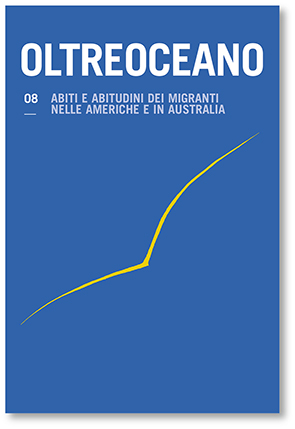Helga Crane: gli abiti di una migrante/emigrante
Parole chiave:
abiti, donna nera, USA, anni '20Abstract
Dopo aver prospettato la situazione degli Afro Americani negli USA dell’Harlem Renaissance, l’intervento si concentra sull’abbigliamento della protagonista del romanzo di Nella Larsen, Sabbie mobili. Nel suo periplo (Sud, Chicago, New York, Copenhagen, New York, Sud), la protagonista è discriminata o vittimizzata dagli altri (bianchi e neri) a causa del suo modo di vestire che coagula i pregiudizi riguardo a razza, genere e sessualità.
Helga Crane: A Migrant / Emigrant’s Clothes
After having sketeched the social and cultural situation of African Americans during the Harlem Renaissance, this paper focuses on the clothes worn by the protagonist of Nella Larsen’s Quicksand. From the South of the US to Chicago to New York to Copenhagen back to New York and the South, she is discriminated and victimized by both whites and blacks because of the way she dresses. Their criticism springs from their prejudices regading race, gender, and sexuality.
Downloads
Riferimenti bibliografici
Agnew, J.-C. (1982): A House of Fiction: Domestic Interiors and the Commodity Aesthetic. In S. Bronner (Ed.), Consuming Visions: Accumulation and Display of Goods in America, 1880-1920 (pp. 133-155). New York: Norton.
Bakhtin, M. (1984): Rabelais and His World. Bloomington: Indiana University Press.
Bourdieu, P. (1984): Distinction: A Social Critique of the Judgment of Taste. Cambridge: Harvard University Press.
Butler, J. (1993): Bodies That Matter. London: Routledge.
Dumenil, L. (1995): Modern Temper. American Culture and Society in the 1920s. New York: Hill and Wang.
Entwistle, J. (2007): Addressing the Body. In M. Barnard (Ed.), Fashion Theory (pp. 273-291). A Reader. London: Routledge.
Foucault, M. (1988): Technologies of the Self. Amherst: University of Massachusetts Press.
Foucault, M. (1995): Discipline and Punish. Trans. Alan Sheridan. New York: Vintage.
Irigaray, L. (1985): The Sex Which Is Not One. Ithaca: Cornell University Press.
Larsen, N. (1989): Quicksand & Passing. London: Serpent’s Tail.
Lauretis, T.de. (1987): Technologies of Gender. Bloomington, IN: Indiana University Press.
Mauss, M. (1973): Techniques of the Body. Economy and Society, 2, 1, pp. 70-88.
Marcuse, H. (1964): One-dimensional Man. Studies in the Ideology of Advanced Industrial Society. London: Routledge.
Nava, Mica. (1987): Consumerism and Its Contradictions. Cultural Studies, 1, 2, pp. 204-210.
Roberts, K. (1997): The Clothes Make the Woman: The Symbolics of Prostitution in Nella Larsen’s Quicksand and Claude McKay’s Home to Harlem. Tulsa Studies in Women’sLiterature, 16, 1, pp. 107-130.
Turner, B. S. (2008): Body and Society. Explorations in Social Theory. London: Sage.
Downloads
Pubblicato
Come citare
Fascicolo
Sezione
Licenza

Questo lavoro è fornito con la licenza Creative Commons Attribuzione - Non commerciale - Condividi allo stesso modo 4.0 Internazionale.
Gli autori si impegnano a rispettare le seguenti condizioni, che s’intendono accettate al momento della sottomissione per la stampa dei propri contributi.
L’invio di un testo implica che esso sia inedito e non in attesa di essere pubblicato altrove.Gli autori si impegnano a rispettare le seguenti condizioni, che s’intendono accettate al momento della sottomissione per la stampa dei propri contributi.
- Qualora venga accettato, l’autore conferisce all’editore il diritto di pubblicarlo e distribuirlo sia in forma cartacea che nell’edizione elettronica in rete. Gli articoli pubblicati saranno scaricabili e resi disponibili in open access.
- Purché segnali correttamente che la prima pubblicazione è avvenuta sulla rivista «Oltreoceano. Rivista sulle migrazioni», l’autore ha facoltà di: a) riprodurre l’articolo in estratti separati o raccolti in volume; b) pubblicare l’articolo nel proprio sito personale o in quello di corsi di insegnamento purché si tratti di siti di natura non commerciale; c) depositare l’articolo in archivi online di carattere non commerciale, legati all’istituzione di appartenenza o come parte di progetti di diffusione non commerciale e open access dei lavori scientifici.
Non è consentita l’utilizzazione dei contributi da parte di terzi, per fini commerciali o comunque non autorizzati. L’editore declina ogni responsabilità sull’uso non autorizzato del materiale pubblicato sulla rivista.













